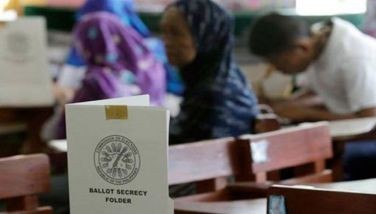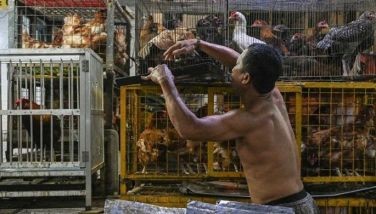‘Farm funds used for GMA campaign’
August 29, 2005 | 12:00am
So when Makati Rep. Teodoro Locsin Jr. was asked last week how he used his P3-million allocation from the DA, he quickly denied ever having received it. "Where did the money go because it sure didn’t go to, well, at least (Las Piñas Rep.) Cynthia Villar and me?" Locsin asked in a privileged speech last Monday.
Part of the answer, according to records obtained from the Office of the Ombudsman and the Commission on Audit (COA), confirms what government critics and farmers’ groups have long been saying: that most of the money went to pro-administration governors, mayors and congressmen who were expected to support President Arroyo’s election.
What the Ombudsman and the COA have so far discovered is that at least P120 million found its way to 15 obscure or non-existent private foundations that had nothing to do with agriculture, but were apparently used as conduits for campaign funds. The investigators still have not traced where hundreds of millions more in DA funds ended up, but these too, they say, were likely diverted to the campaign.
COA auditors were initially baffled by the manner in which the money, disbursed beginning in February 2004, just a week before the start of the 90-day presidential campaign, up to early May, flowed from the national coffers to the DA’s regional and local offices and then to the foundations.
But after months of research, the auditors, who asked not to be named, now say they have uncovered an intricate plot to use the DA’s network to divert money to private groups and entities beyond government control and exempted from the rigors of state accounting procedures.
"It was a well-planned project involving national and local officials and the DA itself, with its nationwide machinery, which ensured easy distribution throughout the country," said a COA source involved in the investigation.
Questions over the use of agriculture funds are not new. Last year, several cases of plunder related to the use of DA funds were filed against President Arroyo and officials of the agriculture and budget departments.
Since last year, the Ombudsman and the COA have been discreetly following the money trail of the DA’s cash-rich Ginintuang Masaganang Ani or GMA Project, a program with several components that include rice-and-corn, livestock and seeds program.
One of these components was the P728 million released on February 3, 2004, supposedly for the agricultural projects of congressional districts, towns and provinces. Another component of the GMA Project is the P1.1 billion, released on February 11, 2004 supposedly for "maintenance and operating expenses."
Both of these funds, according to former Solicitor General Fancisco Chavez, went to legislators, governors and mayors to support the president’s election. Chavez said these were "in reality, an infusion into the political kitty" of Arroyo. He alleges that the president committed plunder when she used government funds for her campaign.
Crucial to the project was Jocelyn "Joc-joc" Bolante, a close friend of First Gentleman Mike Arroyo and his fellow Makati Rotarian. Bolante was named DA undersecretary for finance and administration shortly after Arroyo took over the presidency from Joseph Estrada in 2001. He was in fact the first Arroyo appointee to the department and was already put in charge even before the agriculture secretary, Leonardo Montemayor, was named.
Bolante’s power over the agriculture department was widely known. Last year, just before the start of the campaign, it was he – and not then Agriculture Secretary Luis Lorenzo – who sent letters to various congressmen and local officials informing them of the availability of funds under the DA’s GMA Project.
In that letter, Bolante directed these officials to coordinate with his office "to discuss all the requirements to facilitate the said project fund." Bolante’s letter is dated February 3, 2004, the same day that the Special Allotment Release Order or SARO for the fund was made available by the budget department.
A copy of Bolante’s letter was part of the documents submitted by Chavez to back up his plunder charge. A similar case was filed by the Kilusang Magbubukid ng Pilipinas and other farmers’ groups.
Former DA Undersecretary Ibarra Poliquit admitted Bolante had a hand in determining how the GMA Project funds were spent. He said former DA chief Luis Lorenzo "authorized Bolante to decide on the realignment of funds." Although the DA has a list of officials whose "proposed projects" were to be funded by the GMA Fund, Bolante was given the authority to drop them and replace them with others.
Assistant Secretary and DA Spokesperson Jose Montes insisted "the money was put to good use" funding projects that were proposed by congressmen, governors and mayors themselves. He even cited the growth of the agricultural sector in 2004.
Montes also added that "the election had nothing to do with the timing (of the release of the funds). Ang timing namin always is kung kelan kailangan ng agrikultura yung pera, dun dapat natin ilabas. Hinahabol naming production targets, planting season ng April and May (Our timing is dictated by the needs of the agriculture sector. That’s when we release funds. We have to meet production targets and the April and May planting season)."
Urban-based agriculture
Urban areas also need farm implements, Montes said. In the case of Parañaque, the money went to shredders for composting. And contrary to the impression that there aren’t any farms or rice paddies in Parañaque, Montes said there is "urban agriculture" composed of what he called "vacant-lot farming" and the growing of ornamental plants.
Chavez said that the P728 million was disbursed to 105 congressmen, 53 governors, and 23 city and municipal mayors. He showed a list obtained from the Department of Budget and Management (DBM) attesting to the releases. He also revealed that some of these recipients received actual cash and not farm inputs, as DA rules had prescribed.
It now appears from COA findings that part of the agriculture funds went to questionable foundations. In the Metro Manila and Southern Tagalog region, COA auditors traced the funds to groups like the Gabaymasa Development Foundation, Magsasaka Foundation and Aaron Foundation.
Records of the Securities and Exchange Commission show Gabaymasa’s purpose is "to undertake integrated rehabilitation and restoration activities in areas affected by natural and man-made calamities." Yet the DA issued to the foundation checks worth P23.1 million, supposedly to purchase farm inputs in Quezon, Marinduque, Oriental and Occidental Mindoro, Palawan and Parañaque.
Aaron Foundation, on the other hand, is listed in the SEC as engaging in livelihood projects and daycare centers for street children. It received P5.2 million, supposedly for agriculture projects in Batangas and Palawan.
The SEC has no record of a Magsasaka Foundation but it is listed as the recipient of P6.5 million for farm projects in Palawan.
In the Visayas and Mindanao, the agriculture funds went to various foundations, among them Ikaw at Ako Foundation (P13 million for projects in Bohol, Biliran and Agusan del Norte), Philippine Social Development Foundation (P31 million for projects in Agusan del Sur and del Norte and Surigao del Norte), Matatag na Republika Cooperative P3.2 million for Biliran) and People’s Organization for Progress and Development, Inc. (P5.2 million for Agusan del Sur and Surigao del Sur).
The other findings of the COA and the Ombudsman on these disbursements reveal that:
• In Metro Manila and Southern Luzon, P31 million that was supposed to go to 23 towns and two provinces in chunks of P500,000 or P5 million each was not received by the local government units, even if these local governments were listed as beneficiaries of the fund in the SAROs and Advise of Suballotment (ASA) of the DA central office.
The COA was not able to trace where most of this money went. The municipal treasurers of 19 towns issued certifications that their municipalities did not receive the money. Four other towns that were listed as having received P500,000-Lopez and Tayabas in Quezon and Lemery and San Juan, Batangas-reported to the COA that they got only 5,000 calamansi or mango seedlings, and in the case of Tayabas, also 434 bottles of Foliar fertilizer.
The treasurers of the two provinces listed in the SARO also certified that they did not receive anything from the DA funds. The province of Palawan, for example, did not get the P5 million that was supposedly allotted for it. Instead, a check for P3.2 million from the SARO was paid by the DA to the Magsasaka Foundation Inc.
Marinduque, too, didn’t get its P5-million share. DA records show that P3.2 million that was supposed to go to the province was instead paid out to the Gabaymasa Foundation.
• Seven towns in Bohol supposedly got P10.5 million, except that the entire amount was paid to the Philippine Social Development Foundation. Similarly, P3.8 million intended for two towns in Surigao del Norte, two in Agusan del Sur, and one in Agusan del Norte went through the foundation.
The first district of Surigao del Norte, represented in Congress by Glenda Ecleo, also got P4.3 million coursed through the same foundation. The amount remains unliquidated as of January 2005. The P5 million for the province of Agusan del Norte was also coursed through the same foundation; the money also remains unliquidated. Both Ecleo and Agusan del Norte Gov. Angelica Amante are staunch Lakas members.
• In contrast, in areas that were known to be staunchly supportive of Arroyo, like Central Luzon, the allocations for local officials were given in cash. This violates DA procurement procedures that state that disbursements from the GMA Project should not be in cash, but in farm inputs or implements.
DA Assistant Secretary Felix Jose Montes insisted no cash disbursements were made from the GMA Project. But COA records show that several provinces, including Rizal, Laguna and Batangas received cash transfers of P3 million to P5 million each during the campaign.
Former Pampanga Gov. and now Senator Lito Lapid also admitted getting P5 million in cash, which he said was put by the provincial government in a trust fund that was used to buy fertilizers and other farm inputs. A Pampanga farmers’ group, however, denied ever getting any support from the provincial government. – with additional reporting by Cheche Lazaro, Booma Cruz, Yvonne Chua, Vinia Datinguinoo, Avigail Olarte, Alecks Pabico and BR Guiruela
BrandSpace Articles
<
>
- Latest
- Trending
Trending
Latest
Trending
Latest
Recommended
































